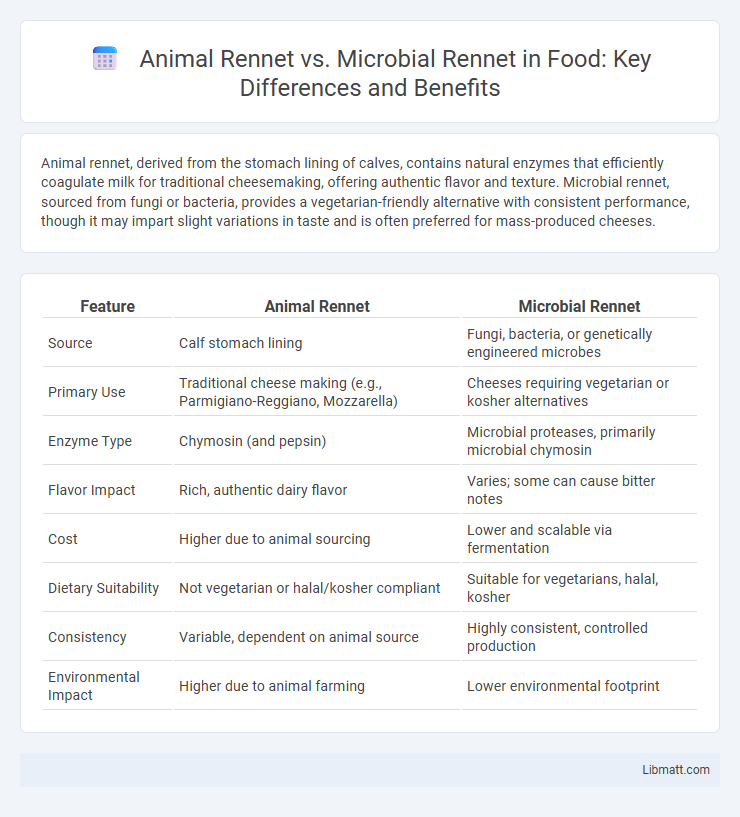Animal rennet, derived from the stomach lining of calves, contains natural enzymes that efficiently coagulate milk for traditional cheesemaking, offering authentic flavor and texture. Microbial rennet, sourced from fungi or bacteria, provides a vegetarian-friendly alternative with consistent performance, though it may impart slight variations in taste and is often preferred for mass-produced cheeses.
Table of Comparison
| Feature | Animal Rennet | Microbial Rennet |
|---|---|---|
| Source | Calf stomach lining | Fungi, bacteria, or genetically engineered microbes |
| Primary Use | Traditional cheese making (e.g., Parmigiano-Reggiano, Mozzarella) | Cheeses requiring vegetarian or kosher alternatives |
| Enzyme Type | Chymosin (and pepsin) | Microbial proteases, primarily microbial chymosin |
| Flavor Impact | Rich, authentic dairy flavor | Varies; some can cause bitter notes |
| Cost | Higher due to animal sourcing | Lower and scalable via fermentation |
| Dietary Suitability | Not vegetarian or halal/kosher compliant | Suitable for vegetarians, halal, kosher |
| Consistency | Variable, dependent on animal source | Highly consistent, controlled production |
| Environmental Impact | Higher due to animal farming | Lower environmental footprint |
Introduction to Rennet and Its Role in Cheesemaking
Rennet, a complex set of enzymes crucial for coagulating milk, initiates the cheese-making process by separating curds and whey, essential for cheese texture and flavor development. Animal rennet, derived from the stomach lining of ruminant calves, contains chymosin as the primary enzyme, renowned for its efficiency in traditional cheese production. Microbial rennet, produced by fungi or bacteria through fermentation, offers a vegetarian alternative with varied enzyme compositions, influencing cheese characteristics and catering to dietary preferences.
Understanding Animal Rennet: Sources and Production
Animal rennet is derived primarily from the stomach lining of young ruminants such as calves, lambs, and kids, where it contains the enzyme chymosin crucial for milk coagulation. The production process involves extracting and purifying chymosin from the abomasum, enabling its use in traditional cheese-making. This natural enzymatic source contrasts with microbial rennet, which is produced through fermentation by fungi, bacteria, or genetically modified microorganisms.
What Is Microbial Rennet? Origins and Extraction
Microbial rennet is an enzymatic substitute for traditional animal rennet, derived from certain fungi or bacteria species, commonly utilized in cheese production to coagulate milk. Unlike animal rennet sourced from the stomach lining of young ruminants, microbial rennet is extracted through fermentation processes involving microorganisms such as Mucor miehei or Rhizomucor pusillus. Your choice between animal and microbial rennet may affect cheese flavor, texture, and suitability for vegetarian diets due to their distinct biochemical origins and extraction methods.
Differences in Enzymatic Activity and Cheese Texture
Animal rennet contains chymosin as its primary enzyme, providing a specific enzymatic activity that results in a firm, traditional cheese texture with well-defined curds. Microbial rennet, derived from fungi or bacteria, features varying protease blends that can lead to a softer or slightly bitter cheese texture due to diverse enzymatic activity. Understanding these differences helps you choose the rennet type that best matches your desired cheese quality and texture preferences.
Flavor Profiles: Animal vs Microbial Rennet Cheeses
Animal rennet cheeses typically develop a smooth, creamy texture with complex, traditional flavor profiles often described as rich, savory, and slightly nutty, due to the natural enzymes derived from calf stomachs that promote slower, more nuanced aging. Microbial rennet cheeses tend to exhibit milder, sometimes slightly tangy or bitter notes, resulting from the fermentation of specific microorganisms, which can influence the cheese's overall taste and aroma, making it a popular choice for vegetarian-friendly options. Your selection between animal and microbial rennet can significantly impact the depth and character of flavors in artisanal cheese production.
Suitability for Vegetarians and Dietary Considerations
Animal rennet, derived from the stomach lining of calves, is unsuitable for vegetarians due to its animal origin, whereas microbial rennet is produced from fungi or bacteria, making it a popular vegetarian-friendly alternative. Microbial rennet also aligns with various dietary restrictions, including kosher and halal, unlike traditional animal rennet. Choosing microbial rennet ensures your cheese products meet diverse dietary preferences without compromising quality.
Cost and Availability: Comparing Both Rennet Types
Animal rennet, derived from the stomach lining of young ruminants, tends to be more expensive due to limited supply and labor-intensive extraction processes, while microbial rennet, produced through fermentation by fungi or bacteria, offers a more cost-effective and scalable alternative. Microbial rennet's widespread availability and consistent quality make it a preferred choice for large-scale cheese production. Animal rennet's fluctuating supply can lead to higher prices and limited accessibility, impacting artisanal cheese makers relying on traditional methods.
Ethical and Environmental Impacts
Animal rennet, derived from the stomach lining of calves, raises significant ethical concerns due to the need for animal slaughter, impacting animal welfare and biodiversity. Microbial rennet, produced through fermentation of fungi or bacteria, offers a more sustainable alternative with a lower environmental footprint, reducing reliance on animal agriculture and associated greenhouse gas emissions. Your choice of rennet can support ethical consumption and environmental sustainability by favoring plant-based or microbial sources over animal-derived options.
Popular Cheese Varieties Made with Each Rennet
Animal rennet, derived from the stomach lining of calves, is traditionally used in popular cheese varieties such as Parmigiano-Reggiano, Mozzarella, and Cheddar, prized for their authentic flavor development and texture. Microbial rennet, produced from fungi and bacteria, is commonly utilized in making vegetarian-friendly cheeses like Gouda, Havarti, and some types of processed cheese, offering a reliable alternative that maintains consistent coagulation. Your choice between these rennets can influence the cheese's flavor profile, suitability for vegetarians, and overall cheesemaking process.
Conclusion: Choosing the Right Rennet for Your Cheese
Choosing the right rennet for your cheese depends on factors like flavor preference, dietary restrictions, and production scale. Animal rennet, derived from calf stomachs, offers traditional flavors ideal for artisanal cheeses, while microbial rennet, produced from fungi or bacteria, suits vegetarian diets and large-scale commercial production. Understanding these differences ensures optimal texture, taste, and suitability for your specific cheesemaking needs.
animal rennet vs microbial rennet Infographic

 libmatt.com
libmatt.com